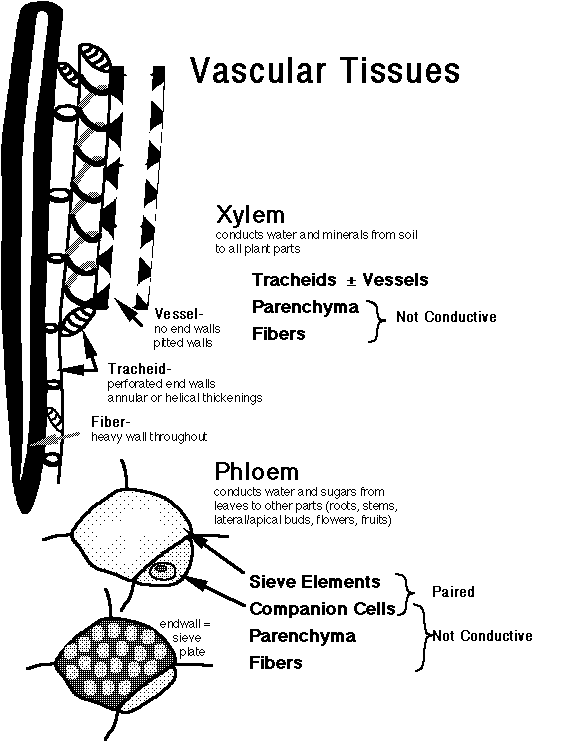Plant Tissue Types
Plant tissues fall into three fundamental categories (among a few others):
- dermal tissue
- ground tissue
- vascular tissue
Dermal Tissues
Dermal tissues generally occupy the "skin" layer of all plant organs. They are responsible for environmental interaction (light passage, gas exchange, pathogen recognition, color display, etc.).
Slides to show examples included a brief discussion of how stoma opening size is regulated by guard cells and how glandular epidermal cells may be involved in herbivore poisoning (THC in epidermal hairs of Cannabis). This dovetailed nicely with your lab exposure to epidermal peels of Rhoeo discolor.
Ground Tissues
This tissue occupies the space between the dermal tissues and the vascular tissues. These cells are much more than just filler, though. In roots the ground tissue may store sugars or starches to fuel the spring sap flow. In leaves, the ground tissue is that layer doing photosythesis, the mesophyll. In many species ground tissues produce intracellular crystals that paralyze potential herbivores.
There is a lot of your book devoted to ground tissue, so that will be discussed more thoroughly as time goes by.
Vascular Tissues
The vascular tissues of higher plants (Kingdom Plantae) are divided into two sections:
xylem and phloem.
Xylem
Xylem is basically a sclerenchyma tissue. Sure it contains some parenchyma, but the rest is sclerenchyma. Some of that sclerenchyma is fiber which does not conduct. The remainder, however, is all conductive. There are two fundamental cell types: tracheids and vessels. Tracheids are thick-walled, have no cytoplasm, and conduct from cell-to-cell through perforation plates in the end walls or through pits in the side walls. The earliest matured tracheids have annular, spiral, or reticulate wall thickenings. Later-maturing tracheids have pitted walls. Vessels are also thick-walled, dead, hollow cells, but lack end walls. They are typically much larger in diameter and are therefore major pipes in the plumbing for water movement. The wall thickenings in vessels are pitted.
Xylem functions in the transport of minerals from the soil up the plant. In the spring sap flow of woody trees, however, the xylem briefly carries lots of sugars and other nutrients from root storage to "jump start" the production of leaves.

Phloem
Phloem is basically a parenchyma tissue. Sure it contains some fibers (some very important such as those in flax that we use to make linen), but the rest is simple parenchyma (non conductive) or the two specialized phloem cell types: Sieve elements and companion cells. Sieve elements are living cells with typical thin walls. The end walls are perforated and called sieve plates. The pores are essentially well-developed plasmodesmata. Since the rate of flow through sieve elements is high, the cytoplasm is very simple, with no developed organelles (no nucleus, no mitochondrion, no chloroplast). To maintain the living state of the sieve element cells, they are directly associated with well-developed, adjacent companion cells by means of plasmodesmata. The companion cell has a typical nucleus and cytoplasm and does enough biochemistry to keep the sieve elements and the companion cells themselves alive. As parenchyma go, sieve elements and companion cells are quite elongate.
Phloem functions in the transport of sugars, amino acids, and other small molecules from the leaf to the rest of the plant. Obviously, it is therefore a bidirectional flow: down to the roots, but also up to the apical buds, flowers, fruits, and seeds.
Go back to the Course Schedule.

